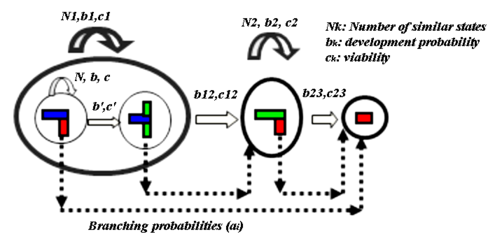GreenLab Course
Development
Stochastic modelling implementation
-
Stochastic structural modelling can easily be implemented on the dual-scale automaton
A sub-structure strategy can be kept for efficient stochastic simulations
Structural factorization can thus also be kept, still allowing formal structure mathematical numbering.
Stochastic automaton
-
Principles
-
The dual-scale automaton can easily simulate stochastic transitions for both micro- and macro-scales.
The principle is that each transition carries a probability of each process (development, mortality, branching) occurring.
Be proceeding in this way, implementation respects the modelling principles, inspired from renewal theory.
Continuous growth
-
The Bernoulli process can be straightforwardly applied to micro-state (phytomers) transitions.
And of course the rhythm ratio and the viability process too.
In practice the rhythm ratio defines first whether or not a Bernoulli trial needs to be performed; then viability c is tested; if the terminal bud is still alive, development is finally tested (choosing a random number compared to the probability b).
Applying the process growth cycle by growth cycle, the simulated axis can be encoded by single "1" and "0" codes, respectively standing for phytomer occurrence and rest.
Rhythmic growth
In theory, the same approach could be implemented for both micro- and macro-scales in the case of rhythmic growth.
However, it is often more efficient to defined the production of the axis for the whole growth unit (the macro-state), and then distribute it (proportionally among micro-states).
First, a random number K of phytomers is defined from the binomial law B(N,b), where N stands for the number of effective growth cycles (after a potential rhythm ratio filter).
The corresponding macro-state thus holds K phytomers, with those mapped on the micro-state sequence defining the macro-state.
The same approach applies to polycyclism, with pre-formed and neo-formed parts. In this case the K definition from the binomial law B(N,p) is replaced by Kp + Kn where Kp stands for the number of phytomers in the pre-formed part (also derived from a binomial law) and Kn stands for the number of phytomers in the neo-formed part (derived from a bionomial or a negative binomial law).
As a result, the construction process leads to a similar output. The simulated axis is encoded by single "1" and "0" codes, respectively standing for phytomer occurrence and rest describing the growth unit sequence. Usually, according to their botanical definition, simulated growth units are separeted from each the other by rest sequences (list of "0").
Branching
-
Each micro-state may carry several whorls of lateral buds of different physiological ages.
Each physiological age branching is tested, i.e. the delay expressed in the growth cycle is estimated.
When coupling is modelled, branching simulation is potentially controlled by the branching results of the previous phytomer.

Stochastic dual scale automaton (Images X. Xhao, Liama-CASIA and P. de Reffye, CIRAD)
- The dual scale automaton transitions are controlled by probabilities.
At micro-scale level, transitions are controlled by the development and the viability probabilities
b and c applied to the first micro-state sequence, while b', and c' apply to the first micro-state to second micro-state sequence.
In the GreenLab model implementation those parameters are identical within macro-states (b=b' and c=c')
Branching probabilities (including delays) are processed by the lower transitions (dotted arrows).
Stochastic sub-structures
-
The use of sub-structures can also be extended to the stochastic case.
Each deterministic substructure is replaced by a set of a limited number of sub-structures, as representative of the sub-structure distribution for the various phytomer typologies (in terms of expected value and variance).
In a first step, the different sub-structure sets are built, starting from the older physiological ages to younger.
At each branching, or physiological mutation, the sub-structures are chosen from ones already created.
For practical reasons, the number of representatives is fixed at the same value, in order to minimize storage and construction costs.

Simulating stochastic sub-structures (Images H.P. Yan, M.G. Kang, Liama-CASIA and P. de Reffye, CIRAD)
- In this example each sub-structure group has five stochastic representatives.
Each representative is built using the higher sub-structure groups.
Each sub-structure group shows appropriate statistical properties (the sample's expected value and variance fit the theoretical values)
